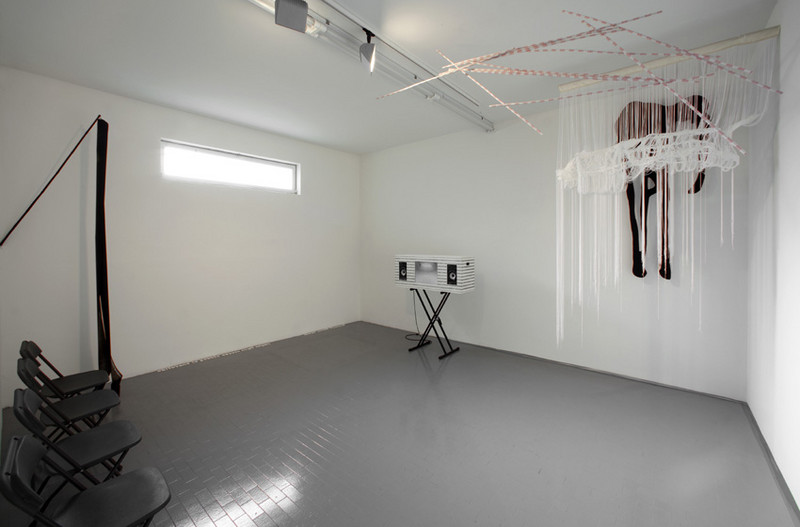Eva Marisaldi
17 Nov 2011 - 05 Jan 2012
EVA MARISALDI
Democratic Psychedelia
17 November, 2011 - 5 January, 2012
This project (whose title plays on the term “Democratic Psychiatry”, an Italian movement that pushed for the reform of mental hospitals in the 1970s) is focused on the workings of the mind. It emerged from the study of various subjects: assisted-living facilities for the elderly, memory, the background of events, and psychedelia as a form of expanded consciousness.
There are enormous reserves of external memory at our disposal, vastly exceeding our individual mnemonic capacities. In our everyday lives, we are used to collecting information to achieve a better grasp of things. So when we interact with people who have lost their short-term memory, we find ourselves in a fix. It all seems useless, our normal methods no longer work. And yet we are communicating.
The process of mental deterioration, invisible as it may be, creates a huge distance between people, even when bonds of affection partially mask this feeling of an unbridgeable gap. We experience, first-hand, what it is like to be caught in a loop. On the other hand, many people who work in nursing homes are skilled at interacting with the “absent-minded”, and do not seem cut off from them. Have they developed a different approach?
The project will unfold in the day room of an assisted-living residence for the elderly, through the creation of “decorations” for the space and construction of an audiovisual machine that automatically generates both music and animated geometric patterns. Its software—specially written for this purpose—never repeats the same images or tunes, since they grow out of random processes. The effect is definitely hypnotic.
For the residents, this constantly shifting river of sounds and images will perhaps just offer an alternative to the television set in the corner, or something to contemplate, or talk about. For everyone else, since it can never be “retained”, this flow will somehow replicate the loss of short-term memory.
The decorations are made of cloth, and while they have been conceived as a sort of “atmospheric sponge”, they are also accessories for each new entrance into the common area. Given their temporary nature, they will offer at least some degree of novelty, then fade into the realm of the familiar. As everyone waits for something new to happen.
The exhibition in the gallery will present drawings based on the photographic documentation of the project, and a room reproducing the common area of the nursing home, where visitors can sit down and experience this type of setting. The installation will not be completely faithful. This audience will be different: better prepared, more distracted, with less time to spare. Still, we’d like to think that it can provide a background for mental activity of some kind.
The project has been realized in collaboration with Enrico Serotti, who created the Democratic Psychedelia machine.
Democratic Psychedelia
17 November, 2011 - 5 January, 2012
This project (whose title plays on the term “Democratic Psychiatry”, an Italian movement that pushed for the reform of mental hospitals in the 1970s) is focused on the workings of the mind. It emerged from the study of various subjects: assisted-living facilities for the elderly, memory, the background of events, and psychedelia as a form of expanded consciousness.
There are enormous reserves of external memory at our disposal, vastly exceeding our individual mnemonic capacities. In our everyday lives, we are used to collecting information to achieve a better grasp of things. So when we interact with people who have lost their short-term memory, we find ourselves in a fix. It all seems useless, our normal methods no longer work. And yet we are communicating.
The process of mental deterioration, invisible as it may be, creates a huge distance between people, even when bonds of affection partially mask this feeling of an unbridgeable gap. We experience, first-hand, what it is like to be caught in a loop. On the other hand, many people who work in nursing homes are skilled at interacting with the “absent-minded”, and do not seem cut off from them. Have they developed a different approach?
The project will unfold in the day room of an assisted-living residence for the elderly, through the creation of “decorations” for the space and construction of an audiovisual machine that automatically generates both music and animated geometric patterns. Its software—specially written for this purpose—never repeats the same images or tunes, since they grow out of random processes. The effect is definitely hypnotic.
For the residents, this constantly shifting river of sounds and images will perhaps just offer an alternative to the television set in the corner, or something to contemplate, or talk about. For everyone else, since it can never be “retained”, this flow will somehow replicate the loss of short-term memory.
The decorations are made of cloth, and while they have been conceived as a sort of “atmospheric sponge”, they are also accessories for each new entrance into the common area. Given their temporary nature, they will offer at least some degree of novelty, then fade into the realm of the familiar. As everyone waits for something new to happen.
The exhibition in the gallery will present drawings based on the photographic documentation of the project, and a room reproducing the common area of the nursing home, where visitors can sit down and experience this type of setting. The installation will not be completely faithful. This audience will be different: better prepared, more distracted, with less time to spare. Still, we’d like to think that it can provide a background for mental activity of some kind.
The project has been realized in collaboration with Enrico Serotti, who created the Democratic Psychedelia machine.

